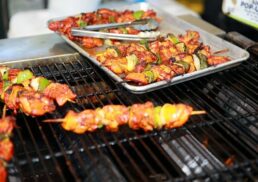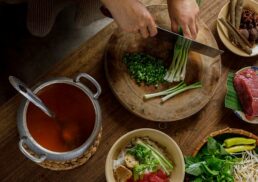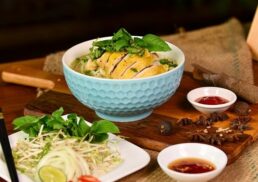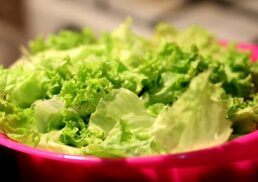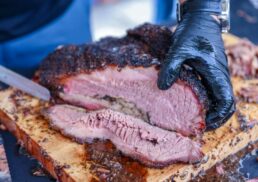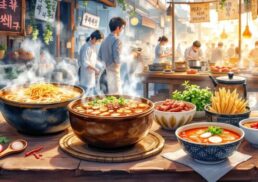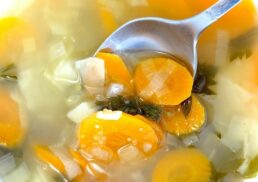Wondering what makes Vietnamese cuisine unique? This guide to 10 must-try dishes will introduce you to the essential flavors and dishes that define the cuisine in Vietnam. From the comforting Phở to the savory Bánh Mì, dive into the culinary delights Vietnam has to offer.
Table of Contents
Key Takeaways
Vietnamese cuisine is rich and diverse, with iconic dishes like Phở, Bánh Mì, and Gỏi Cuốn offering a range of flavors that reflect the country’s cultural history.
Street food is a central element of Vietnamese dining, with popular dishes such as Cơm Tấm and Bún Chả best experienced at local stalls for an authentic taste.
Desserts like Chè highlight the creativity in Vietnamese cuisine, providing a sweet finish to meals with ingredients that are not only delicious but also health-conscious.
Phở: The Quintessential Vietnamese Dish
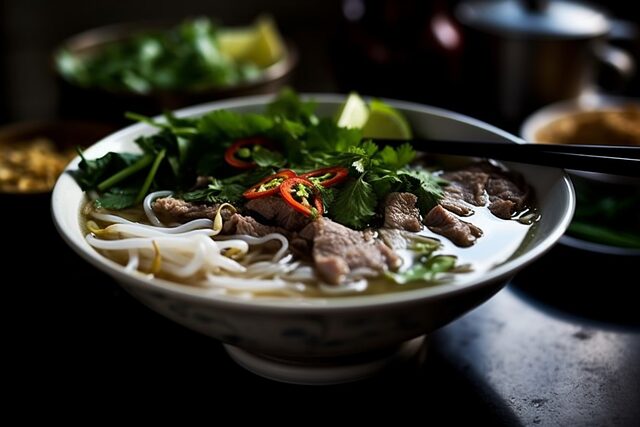
Phở is arguably the most iconic dish in Vietnamese cuisine, a noodle soup that has captured the hearts of food lovers worldwide. Traditionally enjoyed as a breakfast meal, it provides a warm, comforting start to the day. The beauty of Phở lies in its simplicity and the harmonious balance of flavors.
There are two main variations of Phở: the Northern style, typically found in Hanoi, and the Southern style, more common in Ho Chi Minh City. The Northern version features a clear, delicate broth, often served with just a squeeze of lemon and a few slices of chili. In contrast, the Southern version is known for its richer, murkier broth and an abundance of fresh herbs and bean sprouts.
Key ingredients in Phở include flat rice noodles, beef or chicken, and a rich broth enhanced with aromatic spices like star anise, clove, and cinnamon. These spices, along with the slow simmering of beef bones, create a depth of flavor that is both soothing and invigorating. The rice noodles, a staple in many Vietnamese dishes, are derived from Chinese culinary traditions.
To experience authentic Phở, a visit to Pho Thin in Hanoi is highly recommended. This renowned spot serves a version that has been perfected over decades, offering a taste of tradition in every spoonful. The combination of tender meat, fragrant broth, and fresh herbs makes Phở a dish that truly embodies the essence of Vietnamese cuisine.
Phở is more than just a noodle soup; it’s a cultural experience that reflects Vietnam’s history and culinary artistry. Whether you prefer the Northern or Southern style, this dish is a must-try for anyone looking to explore the depth and richness of Vietnamese food.
Bánh Mì: A Fusion of French and Vietnamese Flavors
Bánh Mì is a perfect example of how Vietnamese cuisine has embraced and transformed foreign influences. Originating in Saigon (now Ho Chi Minh City), this sandwich showcases the French colonial impact on Vietnamese food, particularly through the use of the French baguette. The result is a delightful fusion that has become one of the most popular street foods in Vietnam.
Bánh Mì’s versatility is one of its key appeals. Common ingredients include a crispy baguette, pâté, pickled vegetables, fresh cilantro, and various grilled meats like pork, or vegetarian options such as fried tofu. The sandwich’s crunchy crust and soft, airy interior create a delightful contrast, especially when served warm, making it a favorite among street food enthusiasts.
Street food vendors across Vietnam offer unique regional variations of Bánh Mì, each reflecting local tastes and preferences. Some versions might include ingredients like fried eggs, Chinese sausage, or even seafood, showcasing the sandwich’s adaptability to different palates.
Bánh Mì’s popularity is not just confined to Vietnam; it has gained international acclaim, with many Vietnamese restaurants worldwide offering their versions of this delicious sandwich. The combination of flavors and textures in Bánh Mì makes it a standout in the world of street food.
Experiencing Bánh Mì is like taking a bite out of Vietnam’s history, where every ingredient tells a story of cultural fusion and culinary innovation. Whether enjoyed from a street food stall in Ho Chi Minh City or a Vietnamese bakery halfway around the world, Bánh Mì is sure to leave a lasting impression on your taste buds.
Gỏi Cuốn: Fresh Spring Rolls Packed with Flavor
Gỏi Cuốn, also known as fresh spring rolls, is a dish that perfectly captures the essence of Vietnamese cuisine’s emphasis on fresh, healthy ingredients.
Translating to ‘salad rolls,’ Gỏi Cuốn is typically made with:
rice paper
leafy greens
mint
coriander
protein like boiled shrimp and thinly sliced pork
These fresh spring rolls are a refreshing appetizer that sets the stage for more robust flavors to come.
Traditional protein fillings for Gỏi Cuốn often include boiled shrimp and pork belly, providing a savory contrast to the fresh vegetables and herbs. Garlic chive adds a subtle kick that enhances the overall flavor profile. For the rice noodles, bánh hỏi can be used as a less sticky alternative, making the rolling process easier.
Dipping sauces are essential to the Gỏi Cuốn experience. A typical sauce might combine hoisin sauce and peanut butter, often enhanced with garlic for added flavor. Alternatively, some prefer a simple fish sauce or thick soy sauce, each offering a unique taste that complements the fresh ingredients.
Gỏi Cuốn is both delicious and visually appealing, with the vibrant colors of fresh vegetables and herbs peeking through the translucent rice paper. These fresh spring rolls are usually served as appetizers, providing a light and healthy start to a meal.
Whether enjoyed at a street food stall or made at home, Gỏi Cuốn testifies to the beauty of simplicity in Vietnamese cuisine. They offer a burst of flavor and freshness that is satisfying and invigorating, making them a must-try for anyone exploring Vietnamese food.
Cơm Tấm: The Beloved Broken Rice Dish
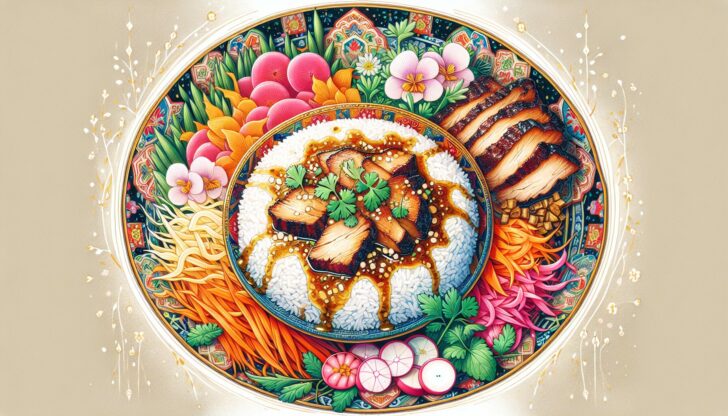
Cơm Tấm, or broken rice, is a beloved dish that has humble origins in Vietnam’s agricultural history. Initially considered a peasant food, Cơm Tấm was made from fractured rice grains that farmers had access to. Over time, this simple rice dish has evolved into a culinary favorite, especially in Southern Vietnam.
The primary component of Cơm Tấm is broken rice, which has a unique texture that absorbs flavors beautifully. It’s often served with grilled pork ribs, fried egg, and pickled vegetables, creating a harmonious blend of textures and flavors. Pickled vegetables add a refreshing crunch, balancing the richness of the grilled pork and fried egg.
Urbanization in the early 20th century transformed Cơm Tấm from a humble farmer’s meal into a dish catering to a variety of tastes, enhancing its cultural significance. Today, Cơm Tấm is enjoyed by people from all walks of life, reflecting its versatile and inclusive nature.
Street food vendors and small eateries in Ho Chi Minh City are great places to start for those looking to try Cơm Tấm. These establishments often serve Cơm Tấm with various accompaniments, allowing diners to customize their meals according to their preferences.
Cơm Tấm demonstrates how simple ingredients can be transformed into a flavorful and satisfying meal. Its journey from the fields to urban eateries highlights the adaptability and resilience of Vietnamese cuisine, making it a dish that is both nostalgic and contemporary.
Bún Chả: Hanoi’s Grilled Pork Patties
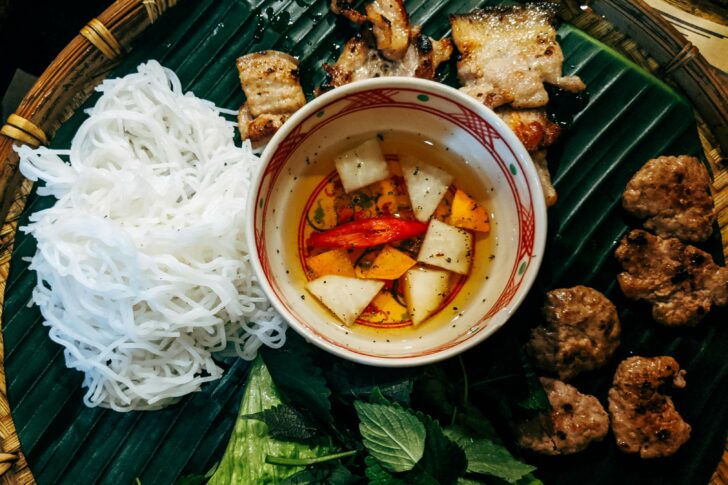
Bún Chả is a quintessential dish from Hanoi, combining the smoky flavors of grilled pork with the freshness of vermicelli noodles and herbs. A staple in Northern Vietnamese cuisine, it offers a perfect balance of savory and fresh elements. Key components include grilled pork patties, pork belly slices, and rice vermicelli noodles.
The secret to juicy pork patties lies in using ground pork with at least 20% fat content, ensuring they remain tender and flavorful. Grilling the meats over charcoal is essential for achieving the characteristic smoky flavor that defines Bún Chả. This smoky aroma, combined with the savory dipping sauce, creates a mouthwatering experience.
The traditional dipping sauce for Bún Chả combines fish sauce, sugar, and water, boiled until dissolved. Served hot, it helps prevent the fat in the meat from solidifying, ensuring each bite remains flavorful. Pickled carrots and kohlrabi are often served alongside, adding a refreshing crunch that complements the rich flavors of the grilled pork.
Bún Chả is best enjoyed with fresh herbs like Thai basil and Vietnamese coriander, which enhance the dish’s overall flavor profile. It gained international fame when President Obama was photographed enjoying it with Anthony Bourdain, further cementing its status as a must-try Vietnamese dish.
Street food stalls in Hanoi’s Old Quarter are the go-to spots for an authentic Bún Chả experience. These stalls offer a taste of tradition, showcasing the culinary artistry behind this delicious dish. Bún Chả perfectly represents Hanoi’s vibrant food culture, combining the best of grilled and fresh flavors.
Learn more, check out the Northern Vietnam Vermicelli Noodles with Grilled Pork Meatballs (Bun Cha Hanoi).
Bánh Xèo: Crispy Vietnamese Pancakes
Bánh Xèo, also known as crispy Vietnamese pancakes, is a dish that brings together the flavors and textures of South and Central Vietnam. These savory pancakes are made from rice flour and coconut milk, filled with pork, shrimp, bean sprouts, and fresh herbs. The result is a crispy, flavorful pancake that is both satisfying and delicious.
The best way to enjoy Bánh Xèo is fresh off the skillet, ensuring its crispy texture remains intact. To eat Bánh Xèo, it should be cut into slices, rolled in rice paper or lettuce, and dipped in fish sauce. This combination of crispy pancake, fresh greens, and savory dipping sauce creates a delightful mix of flavors and textures.
Bánh Xèo is widely eaten in South and Central Vietnam, with each region offering its unique twist on the dish. In some areas, additional ingredients like mushrooms or squid might be added, showcasing the dish’s versatility and regional adaptations.
For those looking to try Bánh Xèo, street food vendors and small eateries in cities like Da Nang and Ho Chi Minh City are excellent places to start. These vendors often cook Bánh Xèo to order, ensuring you get the freshest and crispiest pancakes possible.
Bánh Xèo is a celebration of Vietnamese culinary creativity, combining simple ingredients to create a dish that is both flavorful and fun to eat. Its popularity across different regions highlights the dish’s ability to bring people together, making it a must-try for anyone exploring Vietnamese cuisine.
Mi Quang: Central Vietnam’s Noodle Delight
Mi Quang is a noodle dish that hails from Central Vietnam, particularly Da Nang, and is known for its vibrant yellow rice noodles and unique blend of flavors. This dish is often described as being half soup, half salad, offering a refreshing and hearty meal that is distinctively Vietnamese.
The yellow rice noodles in Mi Quang are infused with turmeric, giving them their characteristic color and a subtle earthy flavor. Common toppings include shrimp, pork, egg, peanuts, and fresh herbs, creating a diverse mix of textures and tastes. Fresh herbs like shredded cabbage, Vietnamese coriander, and perilla leaves are often included, adding a refreshing element to the dish.
Black sesame crackers are a defining topping for Mi Quang, contributing to its traditional flavor and adding a delightful crunch. The broth, sometimes enhanced with shrimp heads, provides a rich and savory base that ties all the ingredients together. This combination of flavors and textures makes Mi Quang a standout dish in Vietnamese cuisine.
Mi Quang is best enjoyed at street food vendors in Hoi An or Da Nang, where you can experience the true essence of this dish. Quan Mi Quang Ba Mua in Da Nang is a recommended place to try Mi Quang, offering a taste of tradition with every bowl.
Mi Quang is often associated with special occasions in Vietnam, such as the Tet festival, highlighting its cultural significance. This noodle dish is a testament to the culinary diversity of Central Vietnam, offering a unique and flavorful experience that is not to be missed.
Chả Cá: Turmeric-Marinated Fish
Chả Cá is a celebrated dish from Hanoi, known for its turmeric-marinated fish and rich history that spans over a century. This dish showcases the unique flavors of Vietnamese cuisine, combining aromatic spices and fresh herbs to create a memorable culinary experience. The key ingredients in Chả Cá include turmeric-marinated fish, fresh dill, and fish similar to catfish.
The preparation of Chả Cá involves marinating the fish in turmeric and other spices, then grilling or frying it until it achieves a golden, crispy exterior. The fish is then served with a generous amount of fresh dill and sometimes other herbs, which add a burst of freshness and complement the savory flavors of the fish. This combination of turmeric and dill creates a unique flavor profile that is both earthy and aromatic.
Before:
For an authentic Chả Cá experience, a visit to Cha Ca La Vong in Hanoi is a must. This restaurant has been serving this specialty for generations, and its reputation for quality and tradition makes it a landmark for food lovers. Other notable places to try Chả Cá include Cha Ca Thang Long Restaurant and more affordable options in Duong Than, Hoan Kiem district.
After:
For an authentic Chả Cá experience, consider visiting:
Cha Ca La Vong in Hanoi, which has been serving this specialty for generations and is renowned for its quality and tradition.
Cha Ca Thang Long Restaurant, another notable place to try Chả Cá.
More affordable options in Duong Than, Hoan Kiem district.
Chả Cá is typically served with vermicelli noodles, fresh herbs, and a dipping sauce made from fish sauce and shrimp paste, which enhances the dish’s overall flavor. This harmonious blend of ingredients and textures makes Chả Cá a standout dish in Vietnamese cuisine.
Whether you’re enjoying Chả Cá at a renowned restaurant or trying it from a local vendor, this dish offers a taste of Hanoi’s culinary heritage. Its unique preparation and distinctive flavors make it a must-try for anyone looking to explore the depths of Vietnamese food.
Xôi: Versatile Sticky Rice
Xôi, or sticky rice, is a versatile staple in Vietnamese cuisine that can be enjoyed in both savory and sweet forms. This glutinous rice dish is a testament to the adaptability of Vietnamese food, offering a wide range of flavors and textures depending on the ingredients used. Xôi is often enjoyed as a breakfast option, providing a hearty and satisfying start to the day.
Savory Xôi typically features 10 to 15 different mix-ins, such as dried shallots, which enhance the flavor and aroma of the dish. Common toppings for savory Xôi include meats, eggs, and sometimes even seafood, making it a diverse and fulfilling meal.
On the other hand, sweet varieties of Xôi, known as xôi ngọt, often incorporate flavors from pandan and Gấc fruit, providing a delightful and aromatic experience. Sweet Xôi is often topped with coconut milk, mung beans, and sometimes durian, creating a rich and creamy texture that is both satisfying and indulgent.
Xôi is traditionally served wrapped in banana leaves, which not only enhances its presentation but also adds a subtle, earthy aroma to the dish.
A recommended place to try Xôi in Hanoi is Xoi Yen, located at 35B Nguyen Huu Huan in the Hoan Kiem district. This eatery is well-known for its variety of Xôi options, allowing diners to experience the full range of flavors that this versatile dish has to offer.
Xôi is a reflection of Vietnamese culinary creativity, showcasing how simple ingredients can be transformed into a diverse array of delicious dishes. Whether you prefer savory or sweet, Xôi offers something for everyone, making it an essential part of any exploration of Vietnamese cuisine.
Chè: A Sweet Ending
Chè is a delightful Vietnamese dessert that offers a sweet ending to any meal. This dessert is known for its layers of jellies, fruits, and coconut milk, providing a refreshing and satisfying treat, especially on a hot day. Chè comes in various forms, each with its unique combination of ingredients and flavors.
One popular type of Chè in the South is Chè Ba Ba, made from sweet potatoes, green beans, cassava, and coconut water. This version is rich and creamy, with a blend of textures that make it a comforting dessert. Another notable variant is Chè Long Nhân Hạt Sen, or sweet lotus seed gruel, which was historically reserved for royalty and features the unique flavor of longan fruit.
Chè Com, or green rice dessert, is a seasonal dish enjoyed in autumn, particularly in Hanoi. Made from flattened rice and arrowroot powder, Chè Com offers a delicate and fragrant flavor that is synonymous with the autumn season. Chè Troi Nuoc, or sweet rice ball soup, has ties to Vietnamese mythology and symbolizes the origins of the Vietnamese people.
Chè Ba Màu is a layered dessert featuring red beans, mashed mung beans, and pandan jelly, often topped with crushed ice for a refreshing finish. Common ingredients in cold Chè include jelly ingredients, tropical fruits like bananas and mangoes, and coconut cream, making it a versatile and delightful treat.
Chè is typically served in a bowl or a glass, allowing you to see the beautiful layers and colors of the dessert. This sweet treat not only satisfies the palate but also offers health benefits, with ingredients chosen for their positive effects on well-being and stress relief. Chè is a perfect way to conclude a meal, leaving you with a sweet and lasting impression of Vietnamese cuisine.
Summary
In summary, Vietnamese cuisine offers a rich tapestry of flavors, textures, and cultural influences that are both diverse and delightful. From the aromatic bowls of Phở to the crispy delights of Bánh Xèo, each dish tells a story of tradition, innovation, and culinary artistry. These ten must-try dishes provide a comprehensive overview of the gastronomic wonders that Vietnam has to offer.
Exploring Vietnamese cuisine is not just about tasting delicious food; it’s about experiencing the history and culture that each dish represents. Whether you prefer the fresh and healthy Gỏi Cuốn or the hearty and comforting Cơm Tấm, there is something for everyone in the vibrant world of Vietnamese food.
We hope this culinary journey has inspired you to try these iconic dishes and discover the magic of Vietnamese cuisine for yourself. Each bite offers a new adventure, a deeper appreciation for the artistry and tradition that goes into every meal. So, embark on this flavorful journey and let your taste buds explore the wonders of Vietnam.
Frequently Asked Questions
What is the difference between Northern and Southern Phở?
Northern Phở has a clear, delicate broth with minimal toppings like lemon and chili, whereas Southern Phở offers a richer, murkier broth packed with fresh herbs and bean sprouts. So, if you enjoy a lighter taste, go for Northern, but if you love bold flavors, Southern is your best bet!
What makes Bánh Mì unique?
Bánh Mì stands out because it blends French and Vietnamese flavors into a crispy baguette filled with delicious ingredients like pâté, grilled meats, and fresh herbs. This tasty fusion makes it a truly one-of-a-kind culinary experience!
How is Gỏi Cuốn typically served?
Gỏi Cuốn is typically served as an appetizer, paired with delicious dipping sauces like hoisin with peanut butter or fish sauce to enhance the flavors. It’s a tasty way to enjoy fresh ingredients!
What are the common toppings for Xôi?
Savory Xôi typically gets delicious toppings like dried shallots, meats, and eggs, while sweet versions are often topped with coconut milk, mung beans, and even durian. It’s all about that tasty balance!
What are some popular types of Chè?
If you’re wondering about popular types of Chè, you can’t go wrong with Chè Ba Ba, Chè Long Nhân Hạt Sen, or the colorful Chè Ba Màu. Each offers a unique blend of flavors and textures that make them delightful treats!
